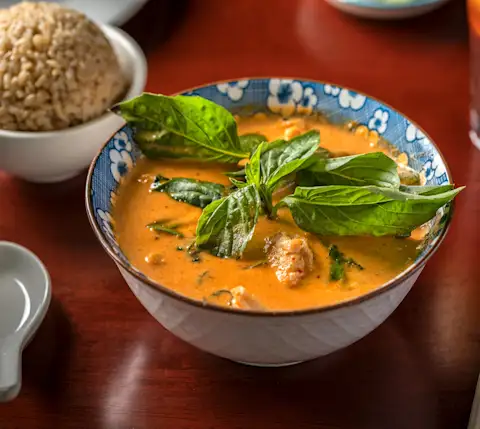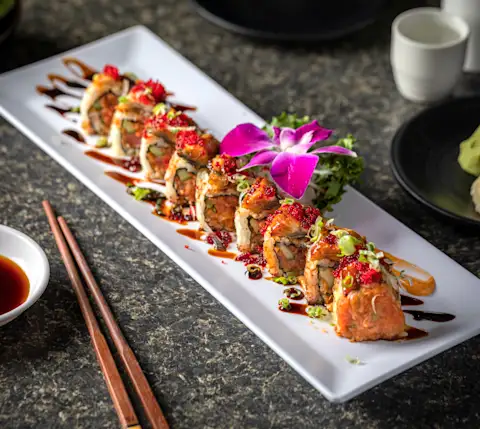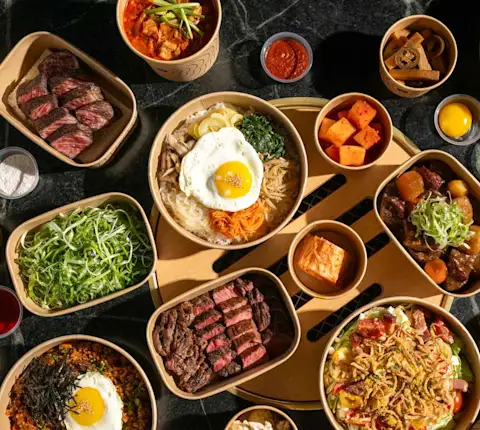Our staff nutritionists have shared their insider tips on what to order at these six types of restaurants, ranging from Mediterranean to Mexican.
Mediterranean
Our staff nutritionists have shared their insider tips on what to order at these six types of restaurants, ranging from Mediterranean to Mexican. Mediterranean cuisine has long been considered one of the healthiest on earth, thanks to its abundance of fish, olive oil, nuts, seeds, and whole grains. These foods are rich in essential nutrients and are a great source of omega-3 fatty acids. These healthy fats protect the heart and can prevent the onset of heart disease later in life. Mediterranean cuisine is plant-forward and generally low in red meat. You will primarily find fish and occasionally poultry in Mediterranean cuisine.
Traditional Mediterranean dishes include:
Grilled fish such as branzino.
Grilled chicken kebabs.
Dips such as baba ganoush and hummus.
Mixed vegetable or whole grain salads such as tabbouleh.
A great way to ensure a healthy, balanced meal is pairing any of these protein items with grilled or sauteéd vegetables and a whole grain such as bulgur (found in tabbouleh). Many Mediterranean restaurants include build-your-own bowls, wraps, and salads, with choices of heart healthy grains, proteins, and toppings. When customizing your order, consider this heart-healthy combo:
A lean protein such as chicken breast or fish.
Whole wheat pita bread.
As many vegetable toppings as possible.
Sauces such as hummus, tzatziki and olive oil-based dressings.
There are quite a few options for healthy, balanced meals when it comes to Mediterranean cuisine. Not only does this cuisine tend to be rich in vegetables, whole grains and lean proteins but the sauces that accompany the dish add flavor without unhealthy attributes.

Thai
Thai cuisine encompasses a diverse range of dishes and preparations, which vary across Northern, Mid-Eastern, Central, and Southern Thailand. In the U.S, many Thai restaurants combine these regional styles into menus that include noodle, rice, and curry-based dishes that incorporate meat, vegetables, and/or seafood. Common seasonings within these dishes include coconut, lemongrass, ginger, garlic, lime, fresh chiles, and turmeric.
Stir-fry is a common cooking style used in Thai cuisine and is a nutritionally balanced option that comes with a lot of flexibility. Animal protein options can range from chicken to beef to seafood, while vegetarians can select tofu or double down on veggies. Vegetables may vary based on what is in season, which maximizes their nutritional value. And many restaurants will offer an option of white or brown rice (opting for brown rice will boost health benefits found in whole grains such as a great source of fiber). While stir-fry exists within many cuisines, Thai-stir fry is a particularly popular option. Healthy dishes within Thai cuisine include:
Stir-frys that combine lean protein such as chicken breast, fish or shrimp with a variety of vegetables. (Stir-fry sauces can contain a high amount of sugar, so opt for a sesame-oi, peanut-oil, or chili sauce instead of a sweet soy, fish, or oyster sauce when possible).
Curries, all of which contain vegetables and a protein option.
Sauteéd vegetable dishes such as broccoli, eggplant or green beans, with a lean protein such as tofu or skinless chicken breast.
Grilled meat or seafood satay.
Salads such as green papaya, larb, or lemongrass — all of which contain fresh vegetables, with an option to add on a lean protein.
Soups such as tom kha, vegetable and ginger.
Chinese
Chinese cuisine is one of the oldest in the world and combines elements from the many diverse regions of China. And in the last hundred-plus years, America’s ubiquitous Chinese takeout restaurants have established a cuisine of their own. Familiar Chinese-American dishes include chow mein, fried rice, kung pao chicken, and beef with broccoli, to name just a few.
A central principle of Chinese cuisine is that food is the center of social interaction, and enjoying a meal in the company of others can actually increase one’s health. Engaging with others, be it friends, family, co-workers (or even strangers) while eating helps us feel connected and eat more mindfully. When it comes to the menu, there are a variety of ways to enjoy a healthful Chinese takeout meal.
Hot and sour soup is flavorful and light, and is usually accompanied by vegetables such as mushrooms and bamboo shoots.
Steamed dumplings are lower in calories and fats than fried dumplings.
Stir-frys such as moo goo gai pan or chicken and broccoli combine a lean protein (chicken) with a light sauce and a variety of vegetables.
Buddha’s delight is a plant-based dish combining tofu with an array of vegetables stir-fried in a light sauce.
Swap is brown rice instead of white for an added boost of filling fiber.

Italian
Italian food in the U.S. encompasses so much more than pizza and pasta. The cuisine is one of several in the Mediterranean whose food is linked to reduced risk of chronic disease and lower levels of inflammation. Why? Because it is based on simple, high quality ingredients: notably olive oil, balsamic vinegar, seasonal produce, and fresh fish, all of which have known health benefits.
Extra virgin olive oil, probably the best known staple of Italian cuisine, is rich in heart-healthy fats and packed with antioxidants. Balsamic vinegar can help regulate blood sugar and improve circulation. Seasonal produce, aside from having delicious flavors, is full of fiber as well as essential vitamins and minerals. And fish is an excellent source of lean protein in addition to containing omega-3 fatty acids.
Here are some of the healthiest Italian food options:
Ribollita and minestrone soup, a classic Tuscan soup packed with fresh vegetables and fiber-rich beans.
Cioppino,a hearty seafood stew full of protein and healthy fats. The tomato base is also high in the antioxidant lycopene, which can help protect cells from damage.
Eggplant Parmigiana, a more nutrient-dense choice than chicken parm that’s high on fiber and antioxidants.
Pasta Primavera, one of the healthier pasta options since it’s chock-full of veggies.
Grilled or poached fish.
When in doubt, steer clear of cream-based sauces (like fettuccine alfredo) and proteins that are breaded or fried.
Mexican
With its rich heritage and vibrant dishes, Mexican cuisine has plenty of uniquely healthy options. Ingredient staples like corn, beans, avocados, tomatillos, agave, and chiles are packed with important nutrients and full of flavor. Americanized Mexican has a reputation for being heavy and unhealthy, but there are plenty of ways to enjoy Mexican food with health in mind.
Some dish suggestions include:
Fajitas, which can come witha lean protein such as chicken, fish, shrimp, or tofu, and lots of peppers and onions, which are full of beta-carotene, potassium, and vitamins A and C.
Whole wheat or stone-ground corn tortillas, which can keep you full with their heart-healthy fiber.
Ceviche, a great source of lean protein, not to mention omega-3 fatty acids and vitamin B12. Though perhaps more traditionally associated with Peru, ceviche is also common throughout Mexico.
Tacos. Start with a whole grain base, like whole wheat or stone ground corn tortillas. Choose lean proteins such as chicken breast, pork loin, grilled fish, or plant-based options like tofu or beans. Finally, replace cheese with heart-healthy fats like avocado or guacamole, and add whatever veggie toppings (pico de gallo, corn, bell peppers, cilantro) you like best!
Burrito bowls.Like tacos, burrito bowls are almost endlessly customizable and can easily be made into a nutritious meal with a few key swaps. Choose brown rice instead of white for a fiber boost, and skip (or go light on) the cheese and sour cream to keep saturated fat and calories in check.
Chicken tortilla soup.Soups can pack a lot of nutrients and flavor into a filling and relatively low-calorie dish. Chicken tortilla soup is full of protein, fiber, vitamins, and minerals: the perfect healthy meal on a chilly day.

Japanese
With its emphasis on fresh, seasonal ingredients and sparing use of red meat, oils, and dairy products, Japanese cuisine is an excellent option if you’re looking for a healthy meal. Traditional ingredients — rice, noodles, fish, tofu, natto, seaweed, fruits, and vegetables — tend to be minimally processed and served simply in a manner that highlights their natural flavors. A great example of this is miso soup, which consists of miso paste mixed into a dashi stock with other ingredients (like tofu, green onions, or seaweed) added based on regional preferences. And while Western influence has introduced larger quantities of meat and processed items into Japanese cuisine, traditional dishes remain widely available.
Traditional Japanese foods have been linked to a variety of health benefits, including improved digestion, protection against chronic disease, and longevity. The island nation’s diet is also naturally rich in omega-3 fatty acids, fiber, vitamins A, C, and E as well as calcium, potassium, magnesium, and iron. So what are the best choices to make at a Japanese restaurant? Steer clear of deep fried items like tempura and select seafood and veggie-forward meals to maximize your nutritional benefit.
Below are some of our picks:
Sushi and sashimi. Sushi grade fish is a great source of omega-3 fatty acids, antioxidants, and important vitamins and minerals.
Maki rolls. Deep fried rolls or anything containing spicy mayo (like spicy tuna) will be higher in fats, while simple rolls with fresh fish and veggies are less calorie-dense overall. Replace white rice with brown for added fiber.
Miso soup. In addition to being a good source of vitamins and minerals, miso also contains probiotics, which can promote gut health and digestion.
Edamame. This fun snack or side dish is a great source of plant-based protein, antioxidants, and fiber.
Oden. The broth-based dish contains a variety of vegetables, tofu, seafood, and/or meat, making it nutrient-dense and filling!
How we define “healthy.”
Our in-house team of nutritionists define healthy as a plant-forward diet that includes a variety of whole, minimally processed foods. This includes a variety of colorful fruits and vegetables, whole grains, lean proteins, heart-healthy fats (found in olive oil, nuts, seeds, etc.) and dairy/dairy alternatives. Small amounts of saturated fats (found in butter, pastries, cured meats like salami, etc), added sugars, heavily processed foods and alcohol can be part of a healthy diet, in moderation.





